Report on Knowledge Management, Culture, and Communities of Practice
VerifiedAdded on 2023/01/18
|15
|4857
|1
Report
AI Summary
This report examines knowledge management practices within the retail sector, using Asda as a case study. It begins by defining and differentiating between explicit and tacit knowledge, and explores the SECI model for knowledge conversion. The report then delves into organizational culture, specifically the categories introduced by Cameron and Quinn, such as clan and adhocracy cultures, and how these cultural frameworks impact organizational behavior and performance. Furthermore, the report highlights the role of communities of practice in generating organizational benefits, particularly within the context of Asda's operations. The report concludes with a discussion on how these elements – knowledge management strategies, cultural frameworks, and community practices – collectively contribute to the overall success of a retail business.
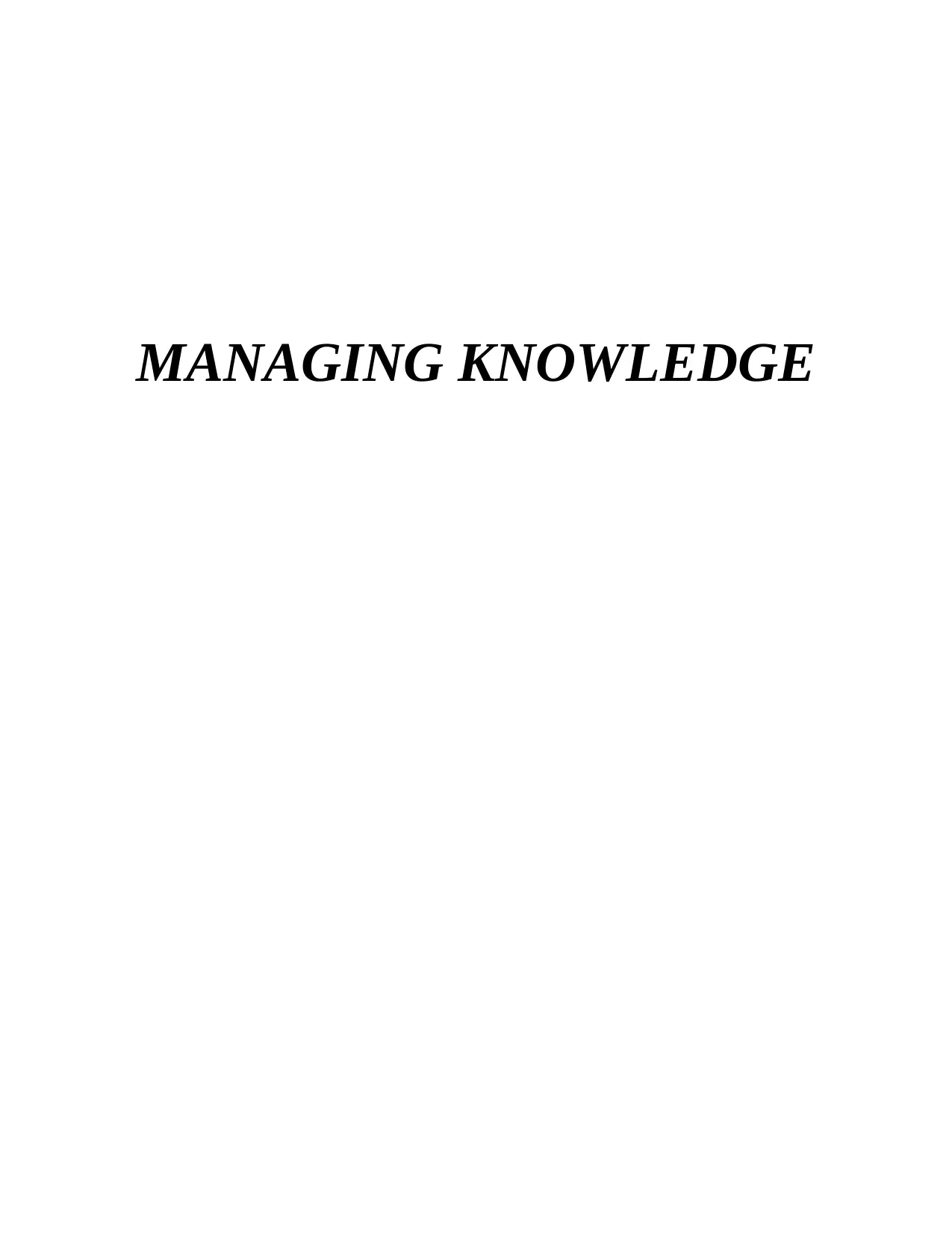
MANAGING KNOWLEDGE
Paraphrase This Document
Need a fresh take? Get an instant paraphrase of this document with our AI Paraphraser
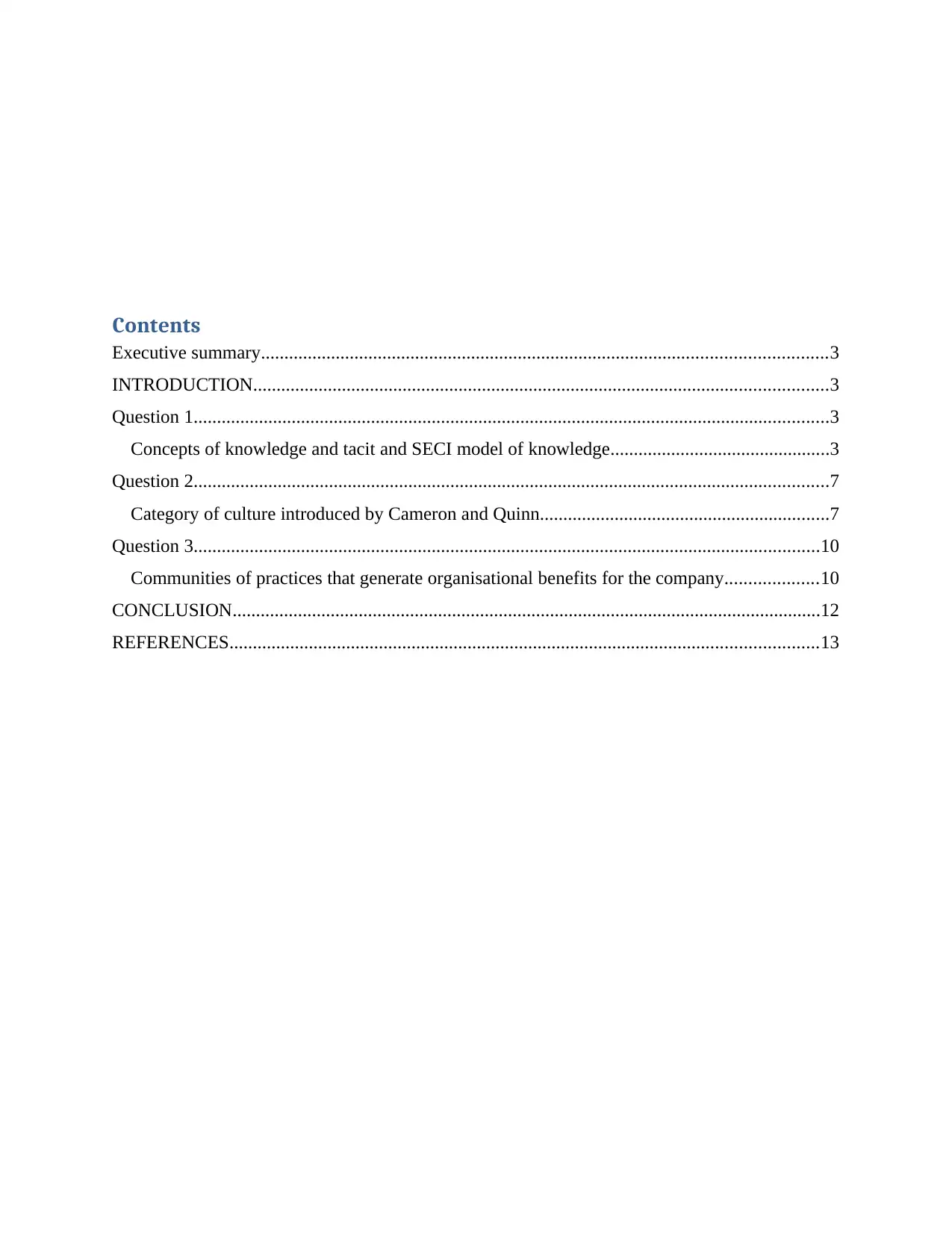
Contents
Executive summary.........................................................................................................................3
INTRODUCTION...........................................................................................................................3
Question 1........................................................................................................................................3
Concepts of knowledge and tacit and SECI model of knowledge...............................................3
Question 2........................................................................................................................................7
Category of culture introduced by Cameron and Quinn..............................................................7
Question 3......................................................................................................................................10
Communities of practices that generate organisational benefits for the company....................10
CONCLUSION..............................................................................................................................12
REFERENCES..............................................................................................................................13
Executive summary.........................................................................................................................3
INTRODUCTION...........................................................................................................................3
Question 1........................................................................................................................................3
Concepts of knowledge and tacit and SECI model of knowledge...............................................3
Question 2........................................................................................................................................7
Category of culture introduced by Cameron and Quinn..............................................................7
Question 3......................................................................................................................................10
Communities of practices that generate organisational benefits for the company....................10
CONCLUSION..............................................................................................................................12
REFERENCES..............................................................................................................................13

⊘ This is a preview!⊘
Do you want full access?
Subscribe today to unlock all pages.

Trusted by 1+ million students worldwide
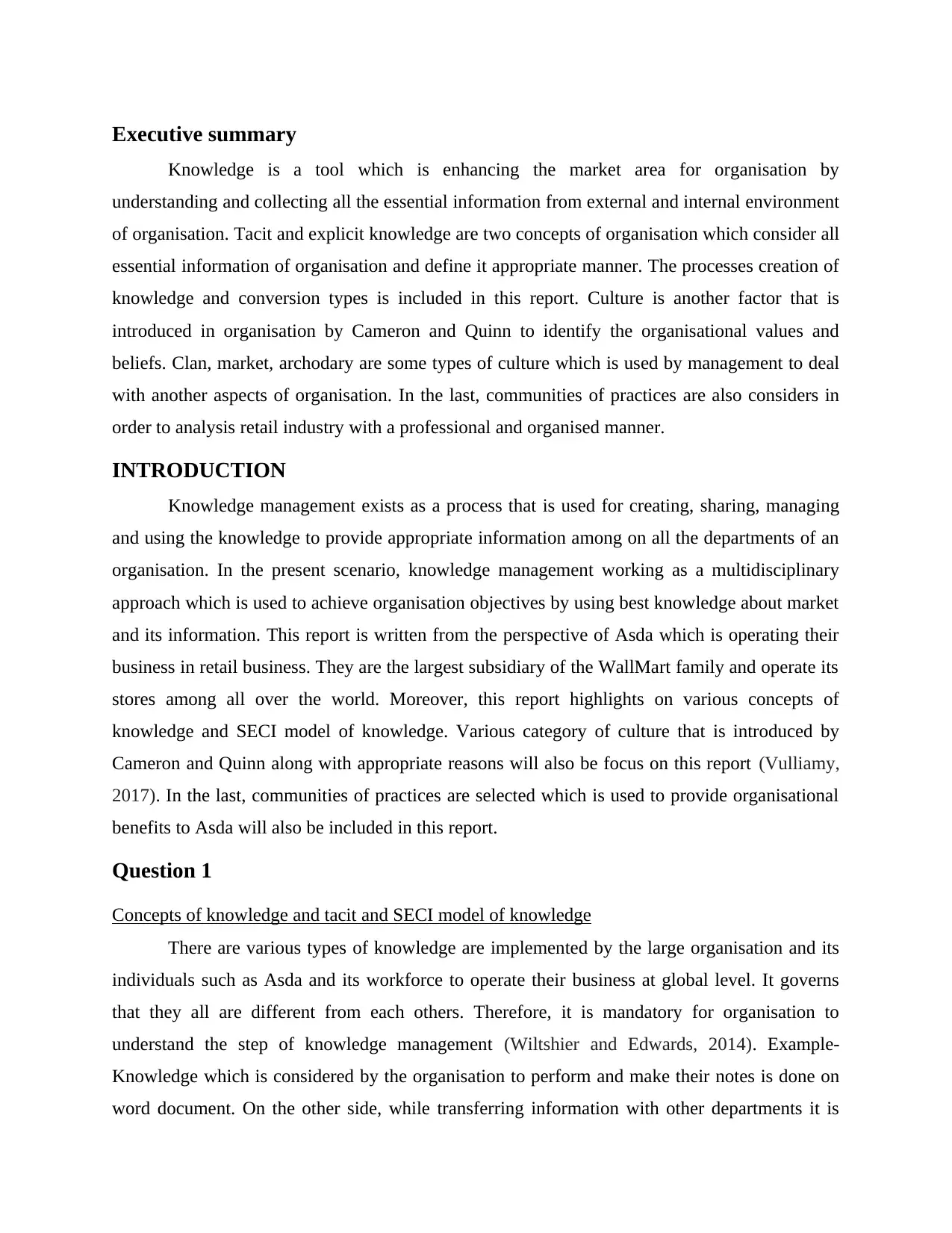
Executive summary
Knowledge is a tool which is enhancing the market area for organisation by
understanding and collecting all the essential information from external and internal environment
of organisation. Tacit and explicit knowledge are two concepts of organisation which consider all
essential information of organisation and define it appropriate manner. The processes creation of
knowledge and conversion types is included in this report. Culture is another factor that is
introduced in organisation by Cameron and Quinn to identify the organisational values and
beliefs. Clan, market, archodary are some types of culture which is used by management to deal
with another aspects of organisation. In the last, communities of practices are also considers in
order to analysis retail industry with a professional and organised manner.
INTRODUCTION
Knowledge management exists as a process that is used for creating, sharing, managing
and using the knowledge to provide appropriate information among on all the departments of an
organisation. In the present scenario, knowledge management working as a multidisciplinary
approach which is used to achieve organisation objectives by using best knowledge about market
and its information. This report is written from the perspective of Asda which is operating their
business in retail business. They are the largest subsidiary of the WallMart family and operate its
stores among all over the world. Moreover, this report highlights on various concepts of
knowledge and SECI model of knowledge. Various category of culture that is introduced by
Cameron and Quinn along with appropriate reasons will also be focus on this report (Vulliamy,
2017). In the last, communities of practices are selected which is used to provide organisational
benefits to Asda will also be included in this report.
Question 1
Concepts of knowledge and tacit and SECI model of knowledge
There are various types of knowledge are implemented by the large organisation and its
individuals such as Asda and its workforce to operate their business at global level. It governs
that they all are different from each others. Therefore, it is mandatory for organisation to
understand the step of knowledge management (Wiltshier and Edwards, 2014). Example-
Knowledge which is considered by the organisation to perform and make their notes is done on
word document. On the other side, while transferring information with other departments it is
Knowledge is a tool which is enhancing the market area for organisation by
understanding and collecting all the essential information from external and internal environment
of organisation. Tacit and explicit knowledge are two concepts of organisation which consider all
essential information of organisation and define it appropriate manner. The processes creation of
knowledge and conversion types is included in this report. Culture is another factor that is
introduced in organisation by Cameron and Quinn to identify the organisational values and
beliefs. Clan, market, archodary are some types of culture which is used by management to deal
with another aspects of organisation. In the last, communities of practices are also considers in
order to analysis retail industry with a professional and organised manner.
INTRODUCTION
Knowledge management exists as a process that is used for creating, sharing, managing
and using the knowledge to provide appropriate information among on all the departments of an
organisation. In the present scenario, knowledge management working as a multidisciplinary
approach which is used to achieve organisation objectives by using best knowledge about market
and its information. This report is written from the perspective of Asda which is operating their
business in retail business. They are the largest subsidiary of the WallMart family and operate its
stores among all over the world. Moreover, this report highlights on various concepts of
knowledge and SECI model of knowledge. Various category of culture that is introduced by
Cameron and Quinn along with appropriate reasons will also be focus on this report (Vulliamy,
2017). In the last, communities of practices are selected which is used to provide organisational
benefits to Asda will also be included in this report.
Question 1
Concepts of knowledge and tacit and SECI model of knowledge
There are various types of knowledge are implemented by the large organisation and its
individuals such as Asda and its workforce to operate their business at global level. It governs
that they all are different from each others. Therefore, it is mandatory for organisation to
understand the step of knowledge management (Wiltshier and Edwards, 2014). Example-
Knowledge which is considered by the organisation to perform and make their notes is done on
word document. On the other side, while transferring information with other departments it is
Paraphrase This Document
Need a fresh take? Get an instant paraphrase of this document with our AI Paraphraser
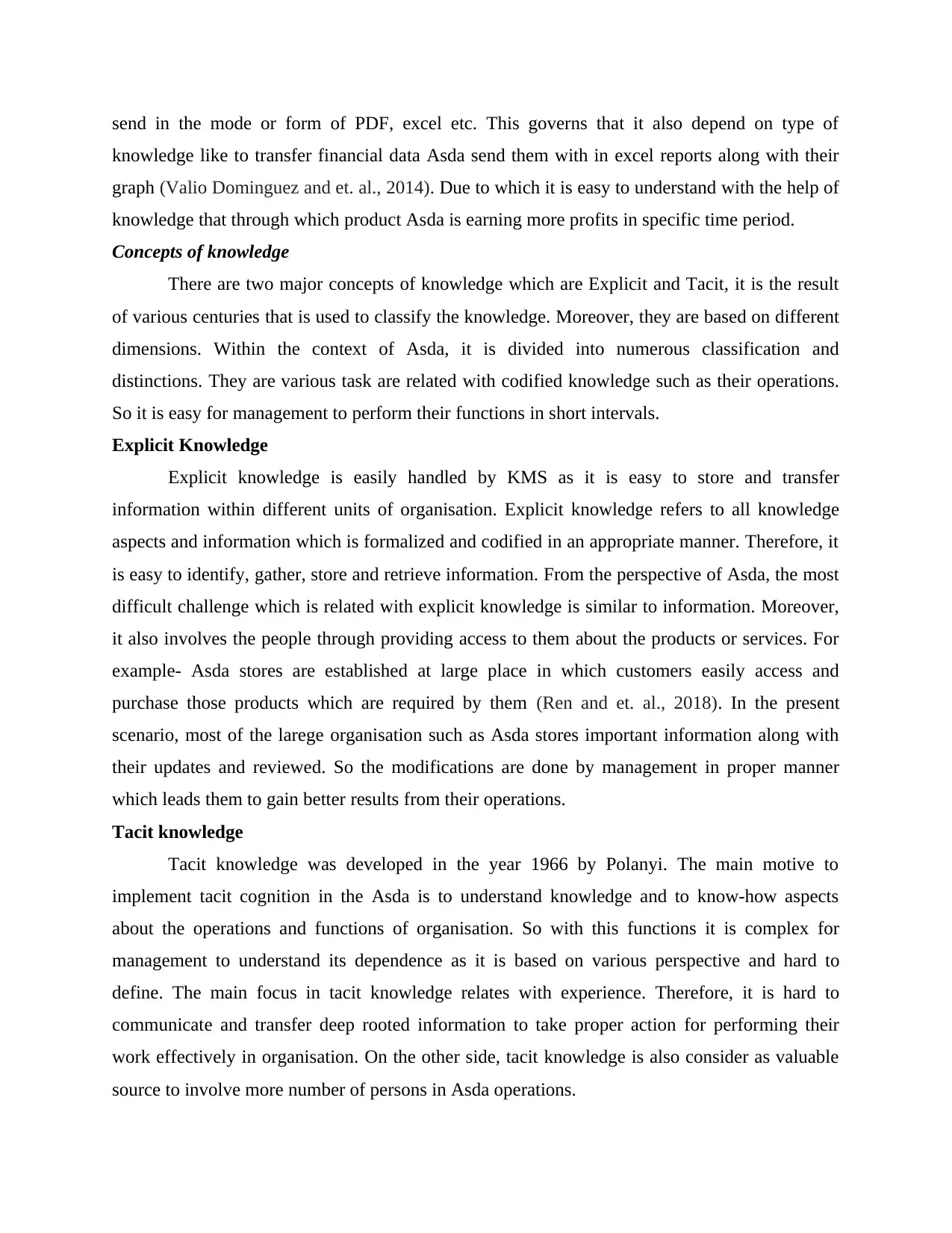
send in the mode or form of PDF, excel etc. This governs that it also depend on type of
knowledge like to transfer financial data Asda send them with in excel reports along with their
graph (Valio Dominguez and et. al., 2014). Due to which it is easy to understand with the help of
knowledge that through which product Asda is earning more profits in specific time period.
Concepts of knowledge
There are two major concepts of knowledge which are Explicit and Tacit, it is the result
of various centuries that is used to classify the knowledge. Moreover, they are based on different
dimensions. Within the context of Asda, it is divided into numerous classification and
distinctions. They are various task are related with codified knowledge such as their operations.
So it is easy for management to perform their functions in short intervals.
Explicit Knowledge
Explicit knowledge is easily handled by KMS as it is easy to store and transfer
information within different units of organisation. Explicit knowledge refers to all knowledge
aspects and information which is formalized and codified in an appropriate manner. Therefore, it
is easy to identify, gather, store and retrieve information. From the perspective of Asda, the most
difficult challenge which is related with explicit knowledge is similar to information. Moreover,
it also involves the people through providing access to them about the products or services. For
example- Asda stores are established at large place in which customers easily access and
purchase those products which are required by them (Ren and et. al., 2018). In the present
scenario, most of the larege organisation such as Asda stores important information along with
their updates and reviewed. So the modifications are done by management in proper manner
which leads them to gain better results from their operations.
Tacit knowledge
Tacit knowledge was developed in the year 1966 by Polanyi. The main motive to
implement tacit cognition in the Asda is to understand knowledge and to know-how aspects
about the operations and functions of organisation. So with this functions it is complex for
management to understand its dependence as it is based on various perspective and hard to
define. The main focus in tacit knowledge relates with experience. Therefore, it is hard to
communicate and transfer deep rooted information to take proper action for performing their
work effectively in organisation. On the other side, tacit knowledge is also consider as valuable
source to involve more number of persons in Asda operations.
knowledge like to transfer financial data Asda send them with in excel reports along with their
graph (Valio Dominguez and et. al., 2014). Due to which it is easy to understand with the help of
knowledge that through which product Asda is earning more profits in specific time period.
Concepts of knowledge
There are two major concepts of knowledge which are Explicit and Tacit, it is the result
of various centuries that is used to classify the knowledge. Moreover, they are based on different
dimensions. Within the context of Asda, it is divided into numerous classification and
distinctions. They are various task are related with codified knowledge such as their operations.
So it is easy for management to perform their functions in short intervals.
Explicit Knowledge
Explicit knowledge is easily handled by KMS as it is easy to store and transfer
information within different units of organisation. Explicit knowledge refers to all knowledge
aspects and information which is formalized and codified in an appropriate manner. Therefore, it
is easy to identify, gather, store and retrieve information. From the perspective of Asda, the most
difficult challenge which is related with explicit knowledge is similar to information. Moreover,
it also involves the people through providing access to them about the products or services. For
example- Asda stores are established at large place in which customers easily access and
purchase those products which are required by them (Ren and et. al., 2018). In the present
scenario, most of the larege organisation such as Asda stores important information along with
their updates and reviewed. So the modifications are done by management in proper manner
which leads them to gain better results from their operations.
Tacit knowledge
Tacit knowledge was developed in the year 1966 by Polanyi. The main motive to
implement tacit cognition in the Asda is to understand knowledge and to know-how aspects
about the operations and functions of organisation. So with this functions it is complex for
management to understand its dependence as it is based on various perspective and hard to
define. The main focus in tacit knowledge relates with experience. Therefore, it is hard to
communicate and transfer deep rooted information to take proper action for performing their
work effectively in organisation. On the other side, tacit knowledge is also consider as valuable
source to involve more number of persons in Asda operations.
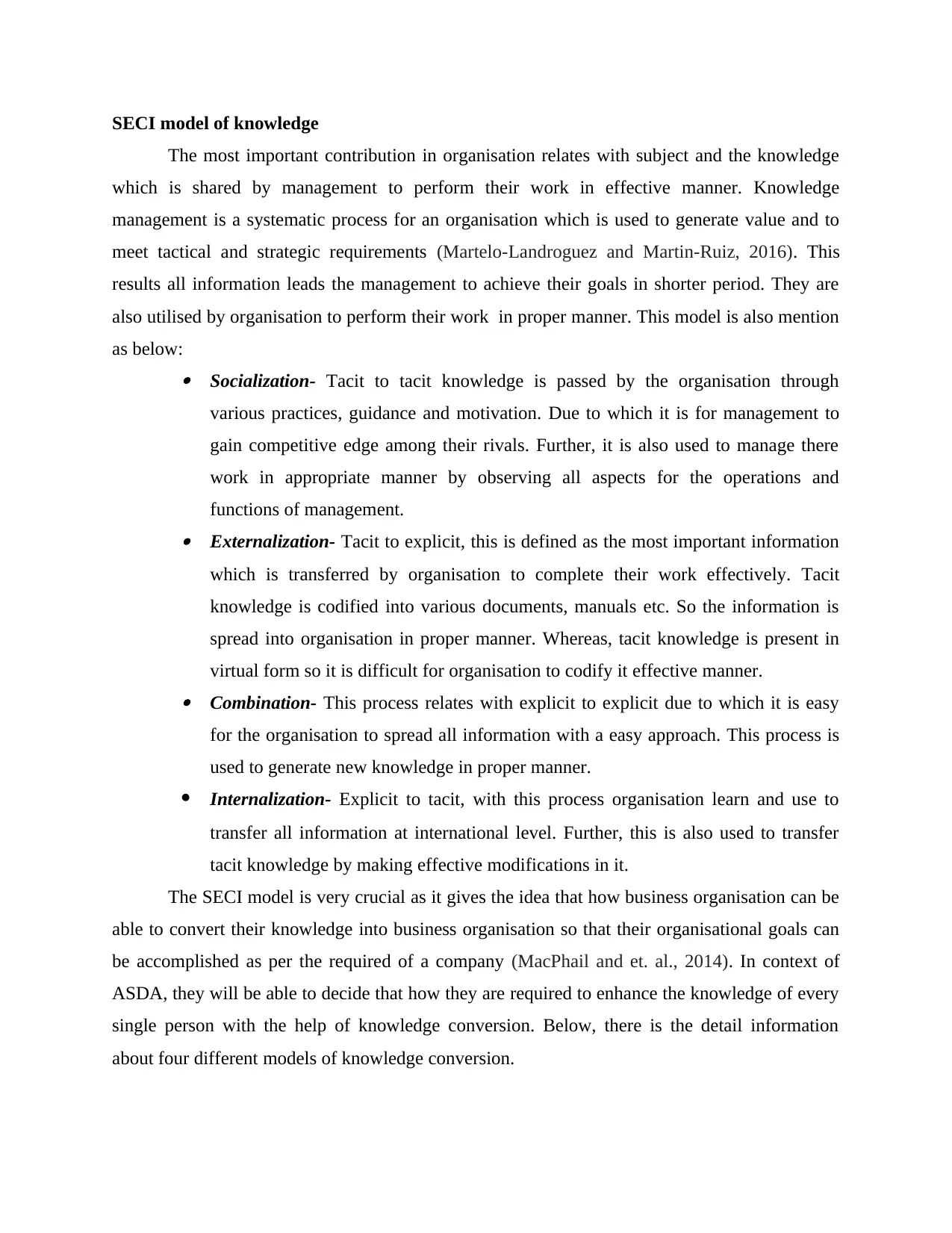
SECI model of knowledge
The most important contribution in organisation relates with subject and the knowledge
which is shared by management to perform their work in effective manner. Knowledge
management is a systematic process for an organisation which is used to generate value and to
meet tactical and strategic requirements (Martelo-Landroguez and Martin-Ruiz, 2016). This
results all information leads the management to achieve their goals in shorter period. They are
also utilised by organisation to perform their work in proper manner. This model is also mention
as below: Socialization- Tacit to tacit knowledge is passed by the organisation through
various practices, guidance and motivation. Due to which it is for management to
gain competitive edge among their rivals. Further, it is also used to manage there
work in appropriate manner by observing all aspects for the operations and
functions of management.
Externalization- Tacit to explicit, this is defined as the most important information
which is transferred by organisation to complete their work effectively. Tacit
knowledge is codified into various documents, manuals etc. So the information is
spread into organisation in proper manner. Whereas, tacit knowledge is present in
virtual form so it is difficult for organisation to codify it effective manner.
Combination- This process relates with explicit to explicit due to which it is easy
for the organisation to spread all information with a easy approach. This process is
used to generate new knowledge in proper manner.
Internalization- Explicit to tacit, with this process organisation learn and use to
transfer all information at international level. Further, this is also used to transfer
tacit knowledge by making effective modifications in it.
The SECI model is very crucial as it gives the idea that how business organisation can be
able to convert their knowledge into business organisation so that their organisational goals can
be accomplished as per the required of a company (MacPhail and et. al., 2014). In context of
ASDA, they will be able to decide that how they are required to enhance the knowledge of every
single person with the help of knowledge conversion. Below, there is the detail information
about four different models of knowledge conversion.
The most important contribution in organisation relates with subject and the knowledge
which is shared by management to perform their work in effective manner. Knowledge
management is a systematic process for an organisation which is used to generate value and to
meet tactical and strategic requirements (Martelo-Landroguez and Martin-Ruiz, 2016). This
results all information leads the management to achieve their goals in shorter period. They are
also utilised by organisation to perform their work in proper manner. This model is also mention
as below: Socialization- Tacit to tacit knowledge is passed by the organisation through
various practices, guidance and motivation. Due to which it is for management to
gain competitive edge among their rivals. Further, it is also used to manage there
work in appropriate manner by observing all aspects for the operations and
functions of management.
Externalization- Tacit to explicit, this is defined as the most important information
which is transferred by organisation to complete their work effectively. Tacit
knowledge is codified into various documents, manuals etc. So the information is
spread into organisation in proper manner. Whereas, tacit knowledge is present in
virtual form so it is difficult for organisation to codify it effective manner.
Combination- This process relates with explicit to explicit due to which it is easy
for the organisation to spread all information with a easy approach. This process is
used to generate new knowledge in proper manner.
Internalization- Explicit to tacit, with this process organisation learn and use to
transfer all information at international level. Further, this is also used to transfer
tacit knowledge by making effective modifications in it.
The SECI model is very crucial as it gives the idea that how business organisation can be
able to convert their knowledge into business organisation so that their organisational goals can
be accomplished as per the required of a company (MacPhail and et. al., 2014). In context of
ASDA, they will be able to decide that how they are required to enhance the knowledge of every
single person with the help of knowledge conversion. Below, there is the detail information
about four different models of knowledge conversion.
⊘ This is a preview!⊘
Do you want full access?
Subscribe today to unlock all pages.

Trusted by 1+ million students worldwide
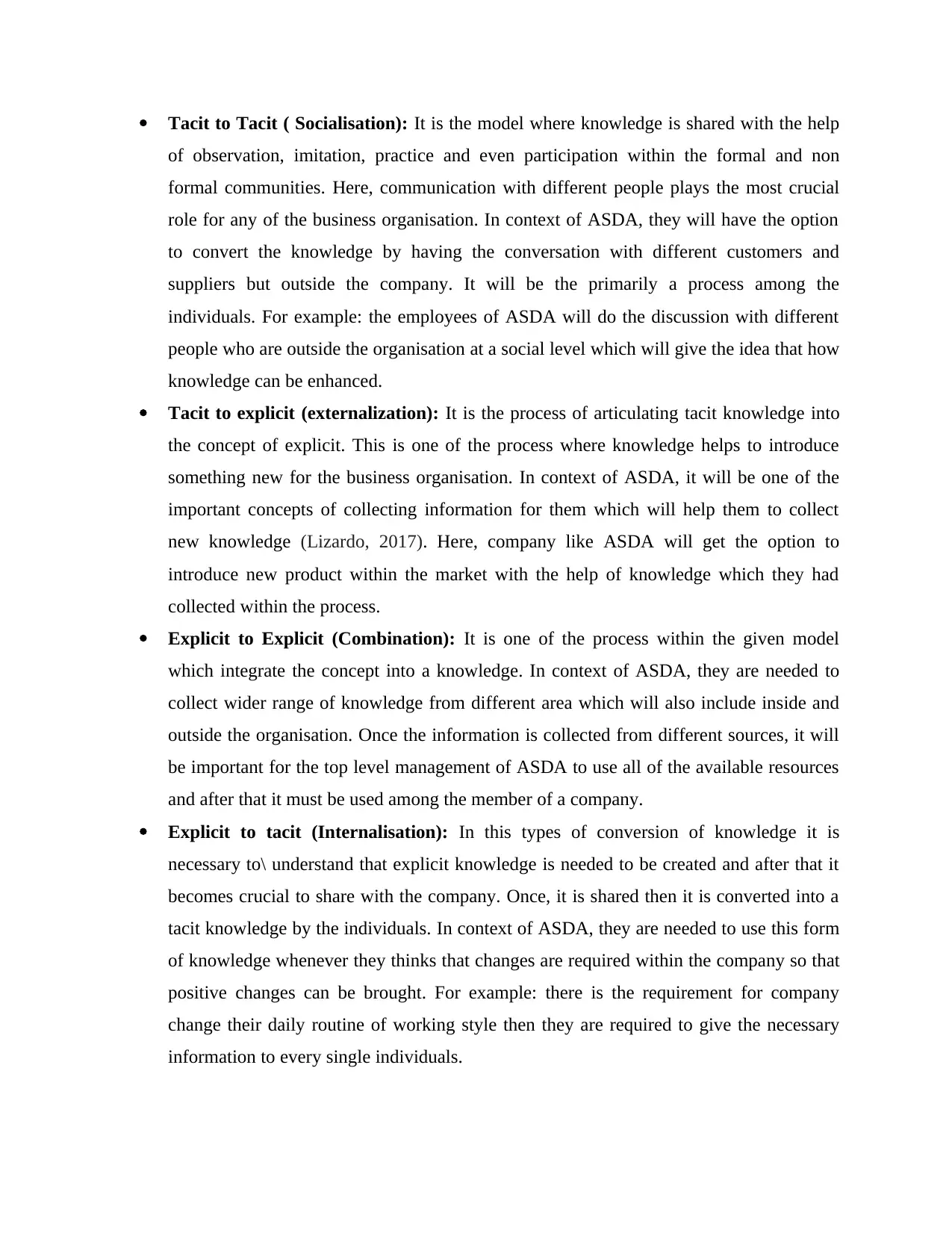
Tacit to Tacit ( Socialisation): It is the model where knowledge is shared with the help
of observation, imitation, practice and even participation within the formal and non
formal communities. Here, communication with different people plays the most crucial
role for any of the business organisation. In context of ASDA, they will have the option
to convert the knowledge by having the conversation with different customers and
suppliers but outside the company. It will be the primarily a process among the
individuals. For example: the employees of ASDA will do the discussion with different
people who are outside the organisation at a social level which will give the idea that how
knowledge can be enhanced.
Tacit to explicit (externalization): It is the process of articulating tacit knowledge into
the concept of explicit. This is one of the process where knowledge helps to introduce
something new for the business organisation. In context of ASDA, it will be one of the
important concepts of collecting information for them which will help them to collect
new knowledge (Lizardo, 2017). Here, company like ASDA will get the option to
introduce new product within the market with the help of knowledge which they had
collected within the process.
Explicit to Explicit (Combination): It is one of the process within the given model
which integrate the concept into a knowledge. In context of ASDA, they are needed to
collect wider range of knowledge from different area which will also include inside and
outside the organisation. Once the information is collected from different sources, it will
be important for the top level management of ASDA to use all of the available resources
and after that it must be used among the member of a company.
Explicit to tacit (Internalisation): In this types of conversion of knowledge it is
necessary to\ understand that explicit knowledge is needed to be created and after that it
becomes crucial to share with the company. Once, it is shared then it is converted into a
tacit knowledge by the individuals. In context of ASDA, they are needed to use this form
of knowledge whenever they thinks that changes are required within the company so that
positive changes can be brought. For example: there is the requirement for company
change their daily routine of working style then they are required to give the necessary
information to every single individuals.
of observation, imitation, practice and even participation within the formal and non
formal communities. Here, communication with different people plays the most crucial
role for any of the business organisation. In context of ASDA, they will have the option
to convert the knowledge by having the conversation with different customers and
suppliers but outside the company. It will be the primarily a process among the
individuals. For example: the employees of ASDA will do the discussion with different
people who are outside the organisation at a social level which will give the idea that how
knowledge can be enhanced.
Tacit to explicit (externalization): It is the process of articulating tacit knowledge into
the concept of explicit. This is one of the process where knowledge helps to introduce
something new for the business organisation. In context of ASDA, it will be one of the
important concepts of collecting information for them which will help them to collect
new knowledge (Lizardo, 2017). Here, company like ASDA will get the option to
introduce new product within the market with the help of knowledge which they had
collected within the process.
Explicit to Explicit (Combination): It is one of the process within the given model
which integrate the concept into a knowledge. In context of ASDA, they are needed to
collect wider range of knowledge from different area which will also include inside and
outside the organisation. Once the information is collected from different sources, it will
be important for the top level management of ASDA to use all of the available resources
and after that it must be used among the member of a company.
Explicit to tacit (Internalisation): In this types of conversion of knowledge it is
necessary to\ understand that explicit knowledge is needed to be created and after that it
becomes crucial to share with the company. Once, it is shared then it is converted into a
tacit knowledge by the individuals. In context of ASDA, they are needed to use this form
of knowledge whenever they thinks that changes are required within the company so that
positive changes can be brought. For example: there is the requirement for company
change their daily routine of working style then they are required to give the necessary
information to every single individuals.
Paraphrase This Document
Need a fresh take? Get an instant paraphrase of this document with our AI Paraphraser
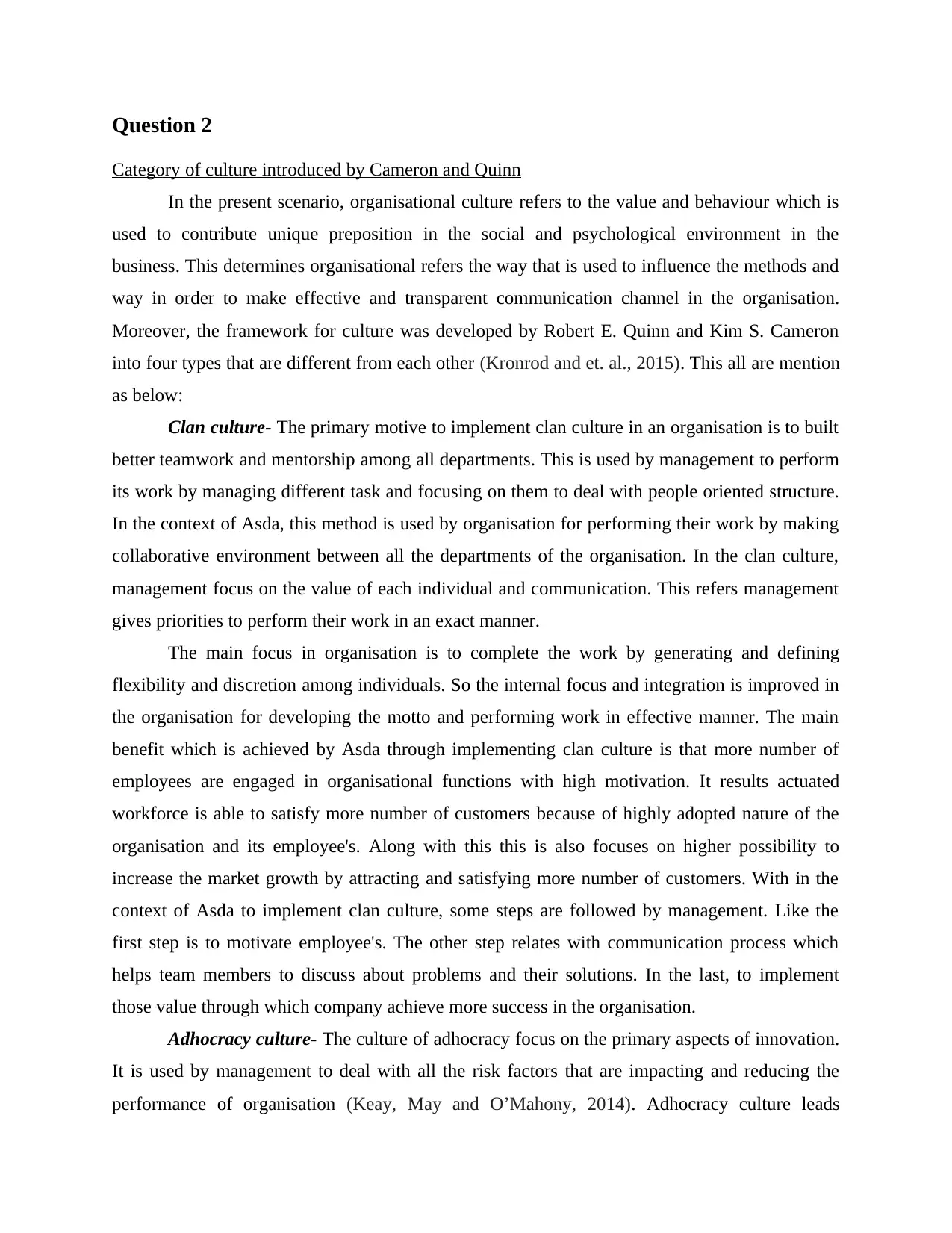
Question 2
Category of culture introduced by Cameron and Quinn
In the present scenario, organisational culture refers to the value and behaviour which is
used to contribute unique preposition in the social and psychological environment in the
business. This determines organisational refers the way that is used to influence the methods and
way in order to make effective and transparent communication channel in the organisation.
Moreover, the framework for culture was developed by Robert E. Quinn and Kim S. Cameron
into four types that are different from each other (Kronrod and et. al., 2015). This all are mention
as below:
Clan culture- The primary motive to implement clan culture in an organisation is to built
better teamwork and mentorship among all departments. This is used by management to perform
its work by managing different task and focusing on them to deal with people oriented structure.
In the context of Asda, this method is used by organisation for performing their work by making
collaborative environment between all the departments of the organisation. In the clan culture,
management focus on the value of each individual and communication. This refers management
gives priorities to perform their work in an exact manner.
The main focus in organisation is to complete the work by generating and defining
flexibility and discretion among individuals. So the internal focus and integration is improved in
the organisation for developing the motto and performing work in effective manner. The main
benefit which is achieved by Asda through implementing clan culture is that more number of
employees are engaged in organisational functions with high motivation. It results actuated
workforce is able to satisfy more number of customers because of highly adopted nature of the
organisation and its employee's. Along with this this is also focuses on higher possibility to
increase the market growth by attracting and satisfying more number of customers. With in the
context of Asda to implement clan culture, some steps are followed by management. Like the
first step is to motivate employee's. The other step relates with communication process which
helps team members to discuss about problems and their solutions. In the last, to implement
those value through which company achieve more success in the organisation.
Adhocracy culture- The culture of adhocracy focus on the primary aspects of innovation.
It is used by management to deal with all the risk factors that are impacting and reducing the
performance of organisation (Keay, May and O’Mahony, 2014). Adhocracy culture leads
Category of culture introduced by Cameron and Quinn
In the present scenario, organisational culture refers to the value and behaviour which is
used to contribute unique preposition in the social and psychological environment in the
business. This determines organisational refers the way that is used to influence the methods and
way in order to make effective and transparent communication channel in the organisation.
Moreover, the framework for culture was developed by Robert E. Quinn and Kim S. Cameron
into four types that are different from each other (Kronrod and et. al., 2015). This all are mention
as below:
Clan culture- The primary motive to implement clan culture in an organisation is to built
better teamwork and mentorship among all departments. This is used by management to perform
its work by managing different task and focusing on them to deal with people oriented structure.
In the context of Asda, this method is used by organisation for performing their work by making
collaborative environment between all the departments of the organisation. In the clan culture,
management focus on the value of each individual and communication. This refers management
gives priorities to perform their work in an exact manner.
The main focus in organisation is to complete the work by generating and defining
flexibility and discretion among individuals. So the internal focus and integration is improved in
the organisation for developing the motto and performing work in effective manner. The main
benefit which is achieved by Asda through implementing clan culture is that more number of
employees are engaged in organisational functions with high motivation. It results actuated
workforce is able to satisfy more number of customers because of highly adopted nature of the
organisation and its employee's. Along with this this is also focuses on higher possibility to
increase the market growth by attracting and satisfying more number of customers. With in the
context of Asda to implement clan culture, some steps are followed by management. Like the
first step is to motivate employee's. The other step relates with communication process which
helps team members to discuss about problems and their solutions. In the last, to implement
those value through which company achieve more success in the organisation.
Adhocracy culture- The culture of adhocracy focus on the primary aspects of innovation.
It is used by management to deal with all the risk factors that are impacting and reducing the
performance of organisation (Keay, May and O’Mahony, 2014). Adhocracy culture leads
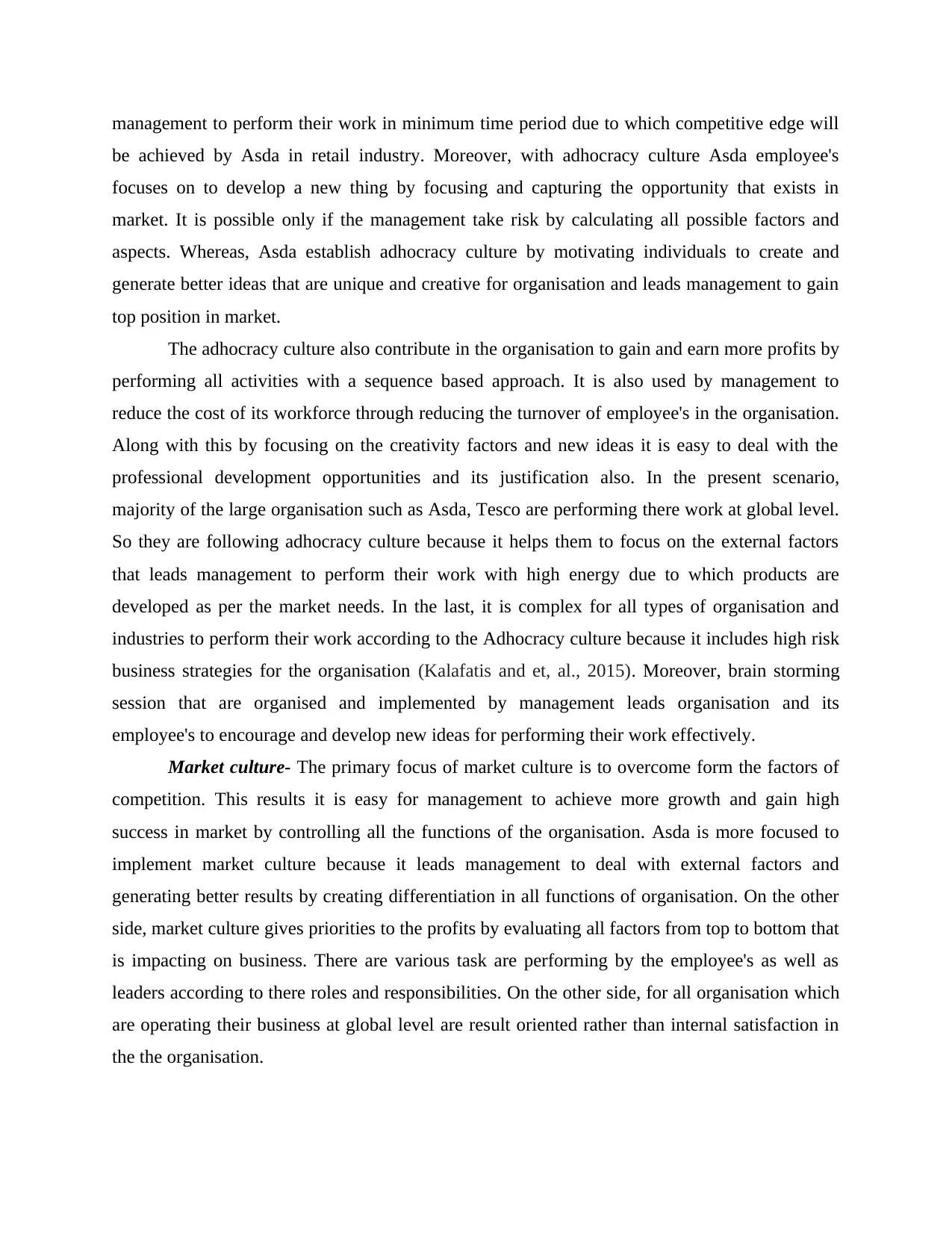
management to perform their work in minimum time period due to which competitive edge will
be achieved by Asda in retail industry. Moreover, with adhocracy culture Asda employee's
focuses on to develop a new thing by focusing and capturing the opportunity that exists in
market. It is possible only if the management take risk by calculating all possible factors and
aspects. Whereas, Asda establish adhocracy culture by motivating individuals to create and
generate better ideas that are unique and creative for organisation and leads management to gain
top position in market.
The adhocracy culture also contribute in the organisation to gain and earn more profits by
performing all activities with a sequence based approach. It is also used by management to
reduce the cost of its workforce through reducing the turnover of employee's in the organisation.
Along with this by focusing on the creativity factors and new ideas it is easy to deal with the
professional development opportunities and its justification also. In the present scenario,
majority of the large organisation such as Asda, Tesco are performing there work at global level.
So they are following adhocracy culture because it helps them to focus on the external factors
that leads management to perform their work with high energy due to which products are
developed as per the market needs. In the last, it is complex for all types of organisation and
industries to perform their work according to the Adhocracy culture because it includes high risk
business strategies for the organisation (Kalafatis and et, al., 2015). Moreover, brain storming
session that are organised and implemented by management leads organisation and its
employee's to encourage and develop new ideas for performing their work effectively.
Market culture- The primary focus of market culture is to overcome form the factors of
competition. This results it is easy for management to achieve more growth and gain high
success in market by controlling all the functions of the organisation. Asda is more focused to
implement market culture because it leads management to deal with external factors and
generating better results by creating differentiation in all functions of organisation. On the other
side, market culture gives priorities to the profits by evaluating all factors from top to bottom that
is impacting on business. There are various task are performing by the employee's as well as
leaders according to there roles and responsibilities. On the other side, for all organisation which
are operating their business at global level are result oriented rather than internal satisfaction in
the the organisation.
be achieved by Asda in retail industry. Moreover, with adhocracy culture Asda employee's
focuses on to develop a new thing by focusing and capturing the opportunity that exists in
market. It is possible only if the management take risk by calculating all possible factors and
aspects. Whereas, Asda establish adhocracy culture by motivating individuals to create and
generate better ideas that are unique and creative for organisation and leads management to gain
top position in market.
The adhocracy culture also contribute in the organisation to gain and earn more profits by
performing all activities with a sequence based approach. It is also used by management to
reduce the cost of its workforce through reducing the turnover of employee's in the organisation.
Along with this by focusing on the creativity factors and new ideas it is easy to deal with the
professional development opportunities and its justification also. In the present scenario,
majority of the large organisation such as Asda, Tesco are performing there work at global level.
So they are following adhocracy culture because it helps them to focus on the external factors
that leads management to perform their work with high energy due to which products are
developed as per the market needs. In the last, it is complex for all types of organisation and
industries to perform their work according to the Adhocracy culture because it includes high risk
business strategies for the organisation (Kalafatis and et, al., 2015). Moreover, brain storming
session that are organised and implemented by management leads organisation and its
employee's to encourage and develop new ideas for performing their work effectively.
Market culture- The primary focus of market culture is to overcome form the factors of
competition. This results it is easy for management to achieve more growth and gain high
success in market by controlling all the functions of the organisation. Asda is more focused to
implement market culture because it leads management to deal with external factors and
generating better results by creating differentiation in all functions of organisation. On the other
side, market culture gives priorities to the profits by evaluating all factors from top to bottom that
is impacting on business. There are various task are performing by the employee's as well as
leaders according to there roles and responsibilities. On the other side, for all organisation which
are operating their business at global level are result oriented rather than internal satisfaction in
the the organisation.
⊘ This is a preview!⊘
Do you want full access?
Subscribe today to unlock all pages.

Trusted by 1+ million students worldwide
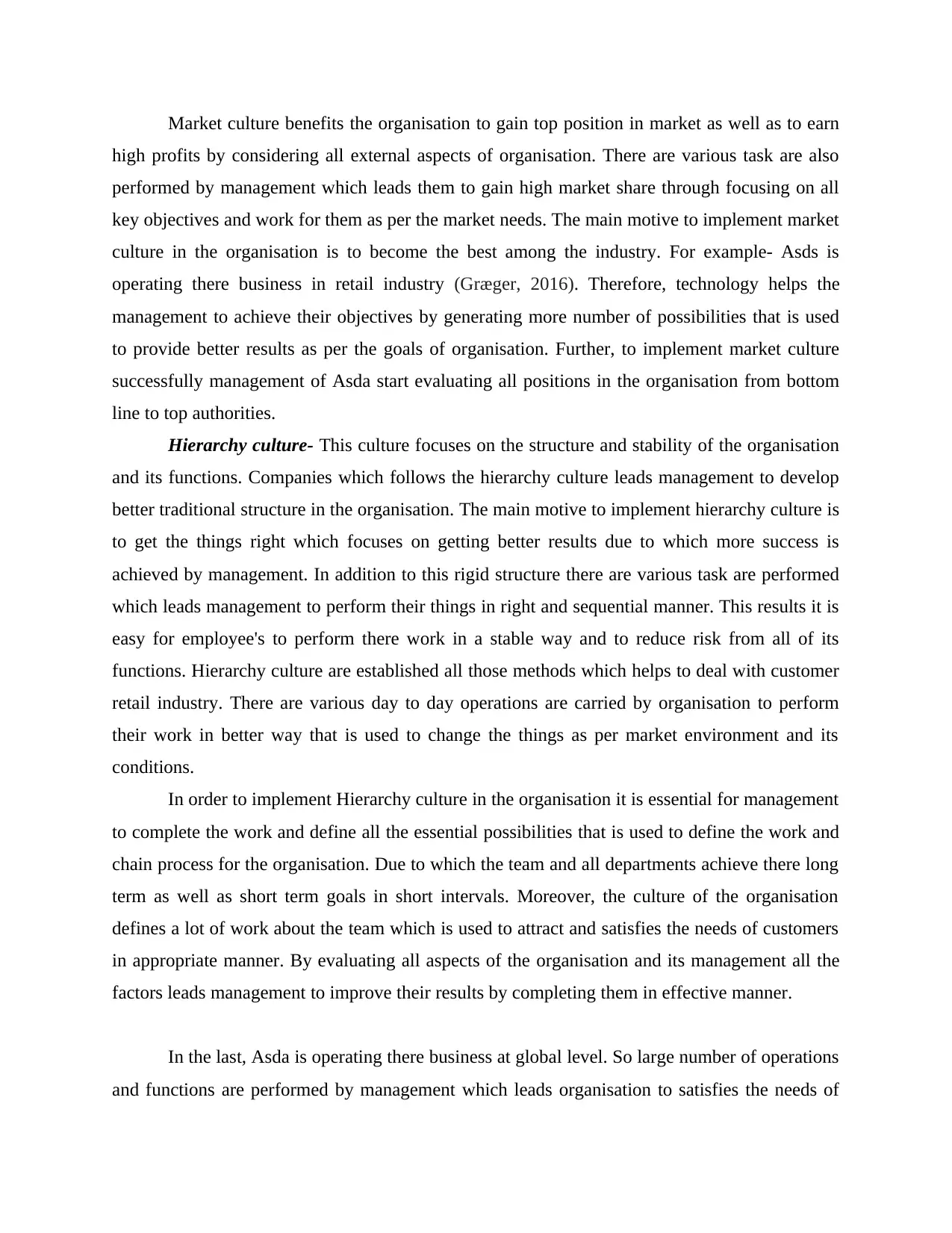
Market culture benefits the organisation to gain top position in market as well as to earn
high profits by considering all external aspects of organisation. There are various task are also
performed by management which leads them to gain high market share through focusing on all
key objectives and work for them as per the market needs. The main motive to implement market
culture in the organisation is to become the best among the industry. For example- Asds is
operating there business in retail industry (Græger, 2016). Therefore, technology helps the
management to achieve their objectives by generating more number of possibilities that is used
to provide better results as per the goals of organisation. Further, to implement market culture
successfully management of Asda start evaluating all positions in the organisation from bottom
line to top authorities.
Hierarchy culture- This culture focuses on the structure and stability of the organisation
and its functions. Companies which follows the hierarchy culture leads management to develop
better traditional structure in the organisation. The main motive to implement hierarchy culture is
to get the things right which focuses on getting better results due to which more success is
achieved by management. In addition to this rigid structure there are various task are performed
which leads management to perform their things in right and sequential manner. This results it is
easy for employee's to perform there work in a stable way and to reduce risk from all of its
functions. Hierarchy culture are established all those methods which helps to deal with customer
retail industry. There are various day to day operations are carried by organisation to perform
their work in better way that is used to change the things as per market environment and its
conditions.
In order to implement Hierarchy culture in the organisation it is essential for management
to complete the work and define all the essential possibilities that is used to define the work and
chain process for the organisation. Due to which the team and all departments achieve there long
term as well as short term goals in short intervals. Moreover, the culture of the organisation
defines a lot of work about the team which is used to attract and satisfies the needs of customers
in appropriate manner. By evaluating all aspects of the organisation and its management all the
factors leads management to improve their results by completing them in effective manner.
In the last, Asda is operating there business at global level. So large number of operations
and functions are performed by management which leads organisation to satisfies the needs of
high profits by considering all external aspects of organisation. There are various task are also
performed by management which leads them to gain high market share through focusing on all
key objectives and work for them as per the market needs. The main motive to implement market
culture in the organisation is to become the best among the industry. For example- Asds is
operating there business in retail industry (Græger, 2016). Therefore, technology helps the
management to achieve their objectives by generating more number of possibilities that is used
to provide better results as per the goals of organisation. Further, to implement market culture
successfully management of Asda start evaluating all positions in the organisation from bottom
line to top authorities.
Hierarchy culture- This culture focuses on the structure and stability of the organisation
and its functions. Companies which follows the hierarchy culture leads management to develop
better traditional structure in the organisation. The main motive to implement hierarchy culture is
to get the things right which focuses on getting better results due to which more success is
achieved by management. In addition to this rigid structure there are various task are performed
which leads management to perform their things in right and sequential manner. This results it is
easy for employee's to perform there work in a stable way and to reduce risk from all of its
functions. Hierarchy culture are established all those methods which helps to deal with customer
retail industry. There are various day to day operations are carried by organisation to perform
their work in better way that is used to change the things as per market environment and its
conditions.
In order to implement Hierarchy culture in the organisation it is essential for management
to complete the work and define all the essential possibilities that is used to define the work and
chain process for the organisation. Due to which the team and all departments achieve there long
term as well as short term goals in short intervals. Moreover, the culture of the organisation
defines a lot of work about the team which is used to attract and satisfies the needs of customers
in appropriate manner. By evaluating all aspects of the organisation and its management all the
factors leads management to improve their results by completing them in effective manner.
In the last, Asda is operating there business at global level. So large number of operations
and functions are performed by management which leads organisation to satisfies the needs of
Paraphrase This Document
Need a fresh take? Get an instant paraphrase of this document with our AI Paraphraser
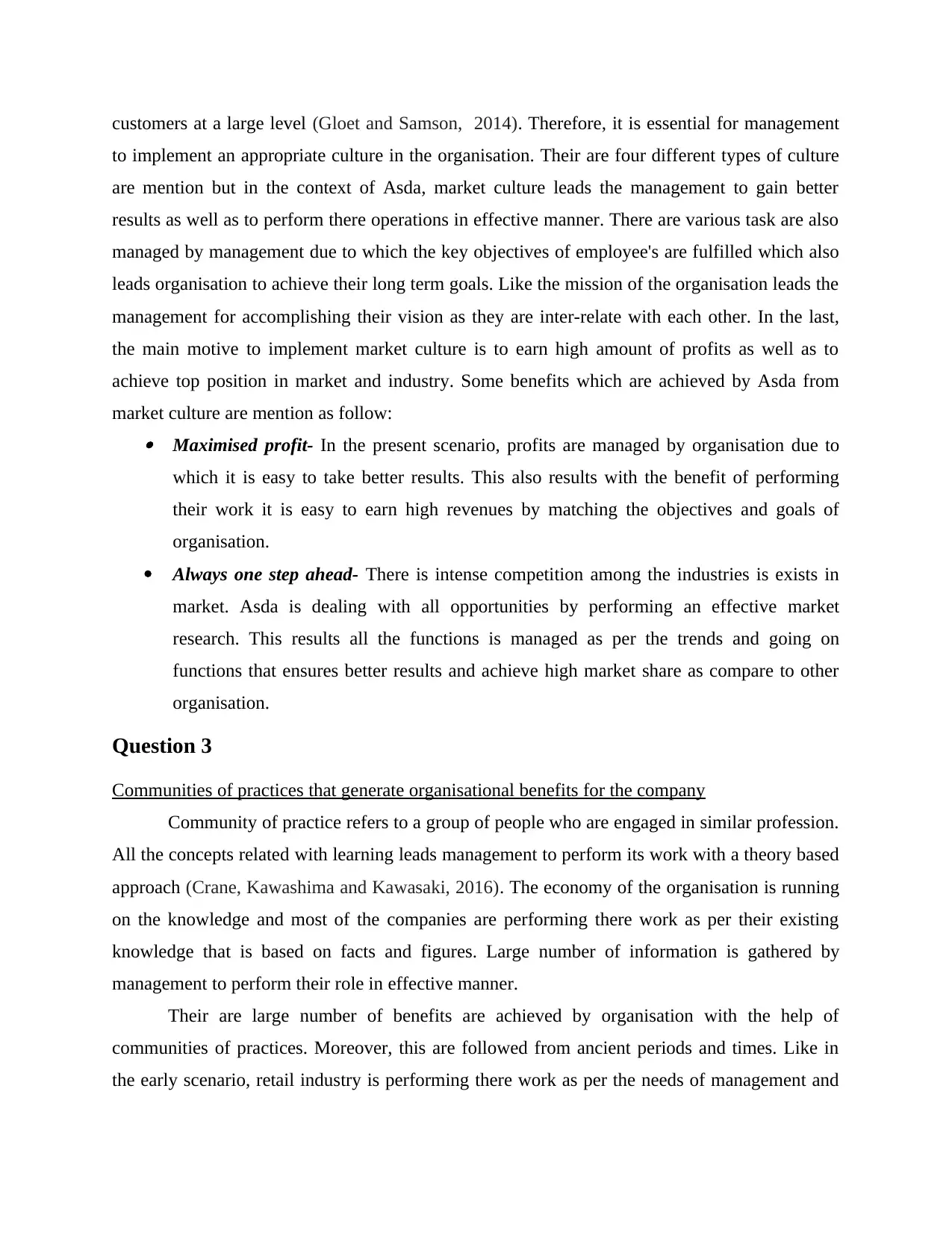
customers at a large level (Gloet and Samson, 2014). Therefore, it is essential for management
to implement an appropriate culture in the organisation. Their are four different types of culture
are mention but in the context of Asda, market culture leads the management to gain better
results as well as to perform there operations in effective manner. There are various task are also
managed by management due to which the key objectives of employee's are fulfilled which also
leads organisation to achieve their long term goals. Like the mission of the organisation leads the
management for accomplishing their vision as they are inter-relate with each other. In the last,
the main motive to implement market culture is to earn high amount of profits as well as to
achieve top position in market and industry. Some benefits which are achieved by Asda from
market culture are mention as follow: Maximised profit- In the present scenario, profits are managed by organisation due to
which it is easy to take better results. This also results with the benefit of performing
their work it is easy to earn high revenues by matching the objectives and goals of
organisation.
Always one step ahead- There is intense competition among the industries is exists in
market. Asda is dealing with all opportunities by performing an effective market
research. This results all the functions is managed as per the trends and going on
functions that ensures better results and achieve high market share as compare to other
organisation.
Question 3
Communities of practices that generate organisational benefits for the company
Community of practice refers to a group of people who are engaged in similar profession.
All the concepts related with learning leads management to perform its work with a theory based
approach (Crane, Kawashima and Kawasaki, 2016). The economy of the organisation is running
on the knowledge and most of the companies are performing there work as per their existing
knowledge that is based on facts and figures. Large number of information is gathered by
management to perform their role in effective manner.
Their are large number of benefits are achieved by organisation with the help of
communities of practices. Moreover, this are followed from ancient periods and times. Like in
the early scenario, retail industry is performing there work as per the needs of management and
to implement an appropriate culture in the organisation. Their are four different types of culture
are mention but in the context of Asda, market culture leads the management to gain better
results as well as to perform there operations in effective manner. There are various task are also
managed by management due to which the key objectives of employee's are fulfilled which also
leads organisation to achieve their long term goals. Like the mission of the organisation leads the
management for accomplishing their vision as they are inter-relate with each other. In the last,
the main motive to implement market culture is to earn high amount of profits as well as to
achieve top position in market and industry. Some benefits which are achieved by Asda from
market culture are mention as follow: Maximised profit- In the present scenario, profits are managed by organisation due to
which it is easy to take better results. This also results with the benefit of performing
their work it is easy to earn high revenues by matching the objectives and goals of
organisation.
Always one step ahead- There is intense competition among the industries is exists in
market. Asda is dealing with all opportunities by performing an effective market
research. This results all the functions is managed as per the trends and going on
functions that ensures better results and achieve high market share as compare to other
organisation.
Question 3
Communities of practices that generate organisational benefits for the company
Community of practice refers to a group of people who are engaged in similar profession.
All the concepts related with learning leads management to perform its work with a theory based
approach (Crane, Kawashima and Kawasaki, 2016). The economy of the organisation is running
on the knowledge and most of the companies are performing there work as per their existing
knowledge that is based on facts and figures. Large number of information is gathered by
management to perform their role in effective manner.
Their are large number of benefits are achieved by organisation with the help of
communities of practices. Moreover, this are followed from ancient periods and times. Like in
the early scenario, retail industry is performing there work as per the needs of management and
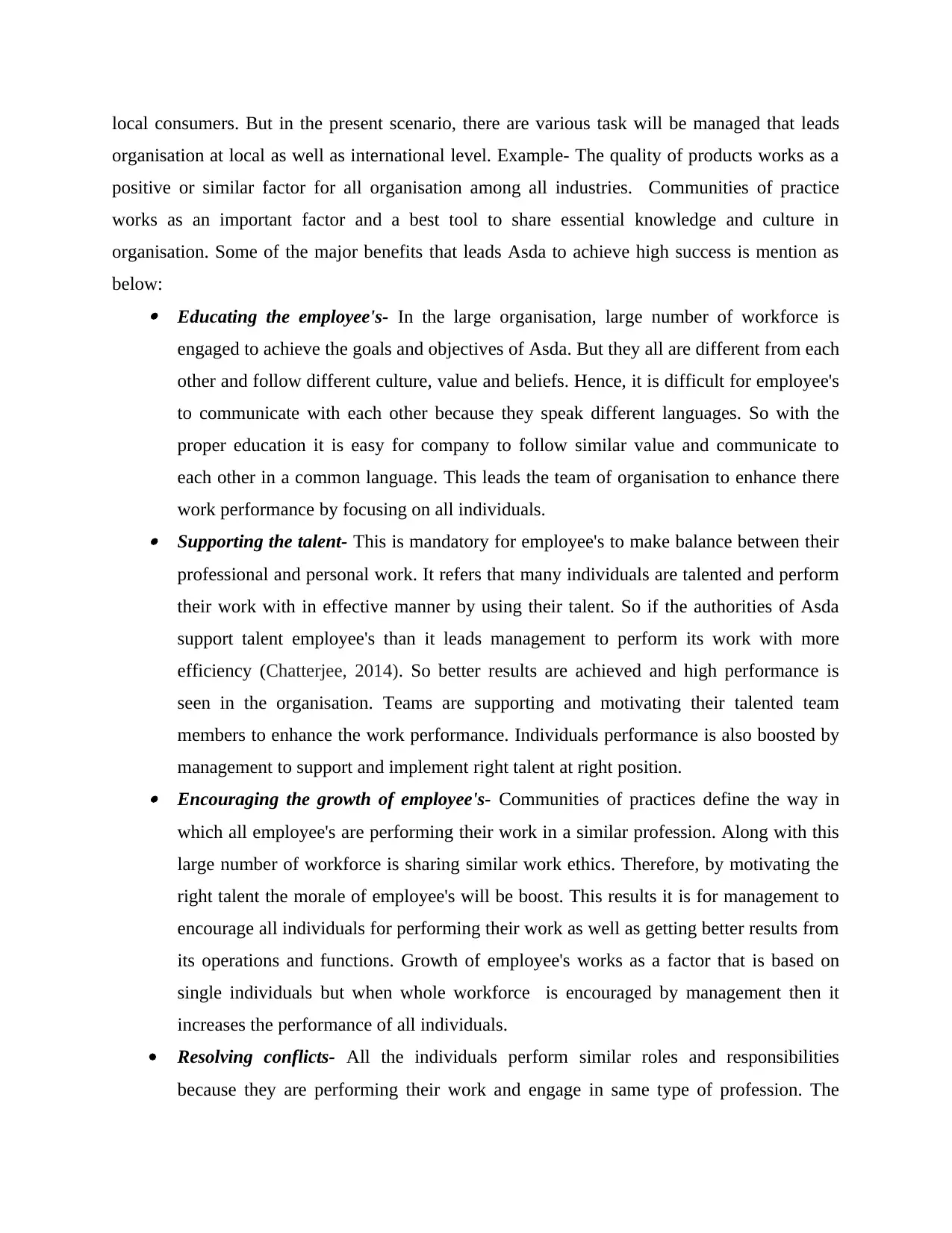
local consumers. But in the present scenario, there are various task will be managed that leads
organisation at local as well as international level. Example- The quality of products works as a
positive or similar factor for all organisation among all industries. Communities of practice
works as an important factor and a best tool to share essential knowledge and culture in
organisation. Some of the major benefits that leads Asda to achieve high success is mention as
below: Educating the employee's- In the large organisation, large number of workforce is
engaged to achieve the goals and objectives of Asda. But they all are different from each
other and follow different culture, value and beliefs. Hence, it is difficult for employee's
to communicate with each other because they speak different languages. So with the
proper education it is easy for company to follow similar value and communicate to
each other in a common language. This leads the team of organisation to enhance there
work performance by focusing on all individuals. Supporting the talent- This is mandatory for employee's to make balance between their
professional and personal work. It refers that many individuals are talented and perform
their work with in effective manner by using their talent. So if the authorities of Asda
support talent employee's than it leads management to perform its work with more
efficiency (Chatterjee, 2014). So better results are achieved and high performance is
seen in the organisation. Teams are supporting and motivating their talented team
members to enhance the work performance. Individuals performance is also boosted by
management to support and implement right talent at right position. Encouraging the growth of employee's- Communities of practices define the way in
which all employee's are performing their work in a similar profession. Along with this
large number of workforce is sharing similar work ethics. Therefore, by motivating the
right talent the morale of employee's will be boost. This results it is for management to
encourage all individuals for performing their work as well as getting better results from
its operations and functions. Growth of employee's works as a factor that is based on
single individuals but when whole workforce is encouraged by management then it
increases the performance of all individuals.
Resolving conflicts- All the individuals perform similar roles and responsibilities
because they are performing their work and engage in same type of profession. The
organisation at local as well as international level. Example- The quality of products works as a
positive or similar factor for all organisation among all industries. Communities of practice
works as an important factor and a best tool to share essential knowledge and culture in
organisation. Some of the major benefits that leads Asda to achieve high success is mention as
below: Educating the employee's- In the large organisation, large number of workforce is
engaged to achieve the goals and objectives of Asda. But they all are different from each
other and follow different culture, value and beliefs. Hence, it is difficult for employee's
to communicate with each other because they speak different languages. So with the
proper education it is easy for company to follow similar value and communicate to
each other in a common language. This leads the team of organisation to enhance there
work performance by focusing on all individuals. Supporting the talent- This is mandatory for employee's to make balance between their
professional and personal work. It refers that many individuals are talented and perform
their work with in effective manner by using their talent. So if the authorities of Asda
support talent employee's than it leads management to perform its work with more
efficiency (Chatterjee, 2014). So better results are achieved and high performance is
seen in the organisation. Teams are supporting and motivating their talented team
members to enhance the work performance. Individuals performance is also boosted by
management to support and implement right talent at right position. Encouraging the growth of employee's- Communities of practices define the way in
which all employee's are performing their work in a similar profession. Along with this
large number of workforce is sharing similar work ethics. Therefore, by motivating the
right talent the morale of employee's will be boost. This results it is for management to
encourage all individuals for performing their work as well as getting better results from
its operations and functions. Growth of employee's works as a factor that is based on
single individuals but when whole workforce is encouraged by management then it
increases the performance of all individuals.
Resolving conflicts- All the individuals perform similar roles and responsibilities
because they are performing their work and engage in same type of profession. The
⊘ This is a preview!⊘
Do you want full access?
Subscribe today to unlock all pages.

Trusted by 1+ million students worldwide
1 out of 15
Related Documents
Your All-in-One AI-Powered Toolkit for Academic Success.
+13062052269
info@desklib.com
Available 24*7 on WhatsApp / Email
![[object Object]](/_next/static/media/star-bottom.7253800d.svg)
Unlock your academic potential
Copyright © 2020–2025 A2Z Services. All Rights Reserved. Developed and managed by ZUCOL.




